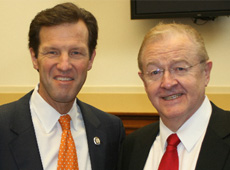Learning from Boston’s early Irish Catholics
Posted By: July 17, 2018
Ray Flynn Saturday, Boston Herald. July 14, 2018
(Raymond L. Flynn is a former mayor of Boston and a former U.S. ambassador to the Vatican.)
It has been my experience growing up that people are more inclined to support the underdog than the powerful. At least that’s how my neighbors and I always felt. Catholic immigrants faced discrimination and oppression when they arrived on these shores, especially those from Ireland. Unfortunately, after a great struggle, Irish-Americans have been reluctant to remind future generations of the religious and economic persecutions they faced. Call it pride, I guess. I’d like to tell you a chapter in that history that I never forgot, as critical today as is was more than 150 years ago.
One day in December 1818, a crowd of 1,000 gathered at the Granary Burying Ground near the Boston Common. Proceeding south, and then east, they covered nearly two miles before reaching their destination in South Boston, arriving at a small piece of land purchased days before by Bishop Jean Cheverus. They carried with them the remains of their beloved Father Francis Matignon, who for 26 years helped establish the Catholic community in Boston, and it was here, at the first Catholic burying ground in Boston, that he would be laid to rest.
Father Matignon arrived in Boston on Aug. 20, 1792, and found the small Catholic population there fighting amongst itself over which of two priests should lead them, and the non-Catholic population leery of their presence. He healed the Catholic community and saw them become accepted members of the community. While the local situation improved, Father Matignon’s responsibility as leader of the Boston mission extended well beyond the city limits, encompassing all Catholics in New England. Realizing the task was more than one priest could handle, he sought assistance by inviting a fellow countryman to join him, Father Jean Cheverus. Largely through their charitable works, the two priests helped the Catholic population gain acceptance among their fellow Bostonians.
As a sign of their growing numbers and stature, they constructed the first Catholic church in New England, the Church of the Holy Cross, in 1803. Five years later, the Boston mission had grown significantly, and so Pope Pius VII elevated it to the Diocese of Boston, intending to name Father Matignon its first bishop. He refused, citing his age and ailments, recommending Father Cheverus instead, and it was he who was ordained as the first bishop of Boston in 1810.
When Father Matignon died on Sept. 19, 1818, his funeral was held at the Church of the Holy Cross, and he was interred in the tomb of John Magner, a prominent Irish businessman, at the Granary Burying Ground. At the time Catholics were usually buried in one of the three public burial grounds within the city limits, but Bishop Cheverus set about finding a resting place more befitting for his dear friend and colleague. He successfully petitioned the Boston Board of Health for permission to establish a Catholic burial ground in the city and purchased land in South Boston on Dec. 9, 1818, reinterring the remains Father Matignon there several days later.
The following year, construction of a mortuary chapel over Father Matignon’s tomb commenced in early May and was dedicated on July 4, 1819. It is believed to be the work of architect Charles Bullfinch, who designed the Massachusetts State House and the Church of the Holy Cross and completed the U.S. Capitol building. Both the chapel and cemetery were dedicated to St. Augustine in honor of an Augustinian priest, Father Philip Lariscy, who raised funds to complete the project.
Originally intended as a small mortuary chapel, it has grown during the past 200 years, reflecting changes in the surrounding neighborhood of South Boston. In the decades following Father Matignon’s death, South Boston saw an influx of Irish Catholic immigrants, often settling there to work the furnaces that fueled the local glasswork industry. Mass was held weekly at the chapel, but it would soon prove inadequate for the growing numbers in attendance, prompting Bishop Cheverus’ successor, Bishop Benedict Fenwick, to expand the chapel. Work included the additions of a choir and sacristy, and mounting the cover of Matignon’s tomb on a wall behind the altar, before rededicating the chapel on Oct. 16, 1831. The chapel would be the sole place of worship for South Boston Catholics until the dedication of Sts. Peter and Paul Church in 1845, and in the 1860s served as the home of St. Augustine parish when it was created, until the new parish church was constructed.
The gravestones have stories to tell. Despite the great progress made in the previous half-century, several cholera epidemics through the mid-19th century revived anti-Catholic sentiments. It was the custom of the Irish Catholics to process with the deceased from the funeral service to their final resting place that raised accusations that by carrying the body through the streets they were spreading the disease. Bishop Fenwick urged local Catholics bury their dead in St. Augustine, away from the burial grounds in the city center, to ease the tension.
Throughout its history, the chapel and cemetery have gone through cycles of decay and repair, the latter coming most often during anniversary celebrations. As we approach yet another anniversary, it is our mission to break the cycle of decay and repair and ensure the site receives regular maintenance for years to come. We appeal for those interested to join the newly formed Friends of St. Augustine Cemetery and make a small contribution to help sustain this historic Catholic site in South Boston. St. Augustine’s Chapel is a symbol of the oppression and discrimination Catholics still face, even if some powerful and well-connected don’t want to admit it.










